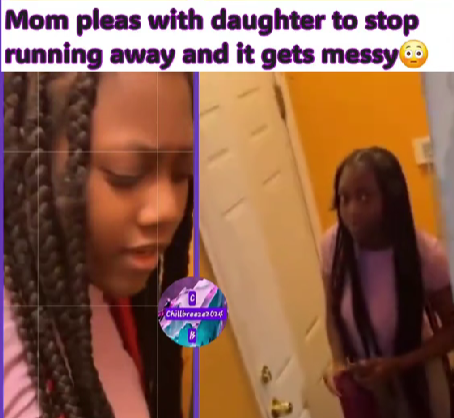A deeply emotional video has gone viral showing a mother pleading with her teenage daughter to stop running away from home — a raw, heartbreaking glimpse into the real struggles many families face behind closed doors.
The footage begins with the mother standing by the door, her voice trembling as she tries to reason with her daughter, who stands silently across the room. It’s clear from their body language that this isn’t the first time this conversation has happened. The mother’s exhaustion and worry show in every word as she pleads, “Please, stop doing this to yourself… to us.”
The daughter, barely able to meet her mother’s eyes, shifts uncomfortably. Her expression is torn between anger, frustration, and guilt — emotions familiar to any parent-teen conflict. But what makes this moment so powerful is the mother’s tone — not one of punishment or control, but of pure desperation and love.
According to reports accompanying the viral video, the girl had repeatedly left home after arguments, each time sparking panic and late-night searches. While she eventually returned safely, the emotional toll on both sides had become unbearable. This video, filmed by a relative hoping to document the situation, captures the breaking point — the moment when love and fear collide.
Experts say that runaway behavior among teens often stems from feelings of misunderstanding, emotional neglect, or a desire for independence — not necessarily from bad parenting or rebellion alone. “Teens run when they feel trapped or unheard,” said one family therapist. “It’s not always about defiance. Often, it’s a cry for connection.”
The internet’s reaction to the clip has been overwhelmingly emotional. Thousands of comments poured in, many from parents who said they recognized the pain in the mother’s voice. “This broke me,” one comment read. “You can hear years of worry in her tone.” Others shared their own experiences, urging both parents and teens to seek counseling and open communication rather than letting anger build up.
Parenting experts stress that the best way to handle repeated runaway situations is through empathy, safety planning, and consistent support — not through confrontation alone. They recommend keeping lines of communication open, validating the teen’s emotions, and seeking professional help early. “It’s not about control,” one counselor said. “It’s about rebuilding trust, one conversation at a time.”
For the family in the video, this painful moment might also mark the start of healing. The mother’s willingness to express vulnerability — instead of anger — resonated deeply with viewers who saw love, not failure, in her tears.
In the end, the video serves as a reminder that behind every “runaway story” is a family struggling to stay connected in a world that often pulls people apart. It’s a call for compassion — for parents trying to guide, and for teens still learning how to listen. Because sometimes, the most powerful thing we can say is simply, “Please come home.”
